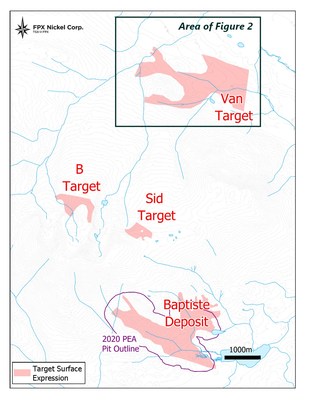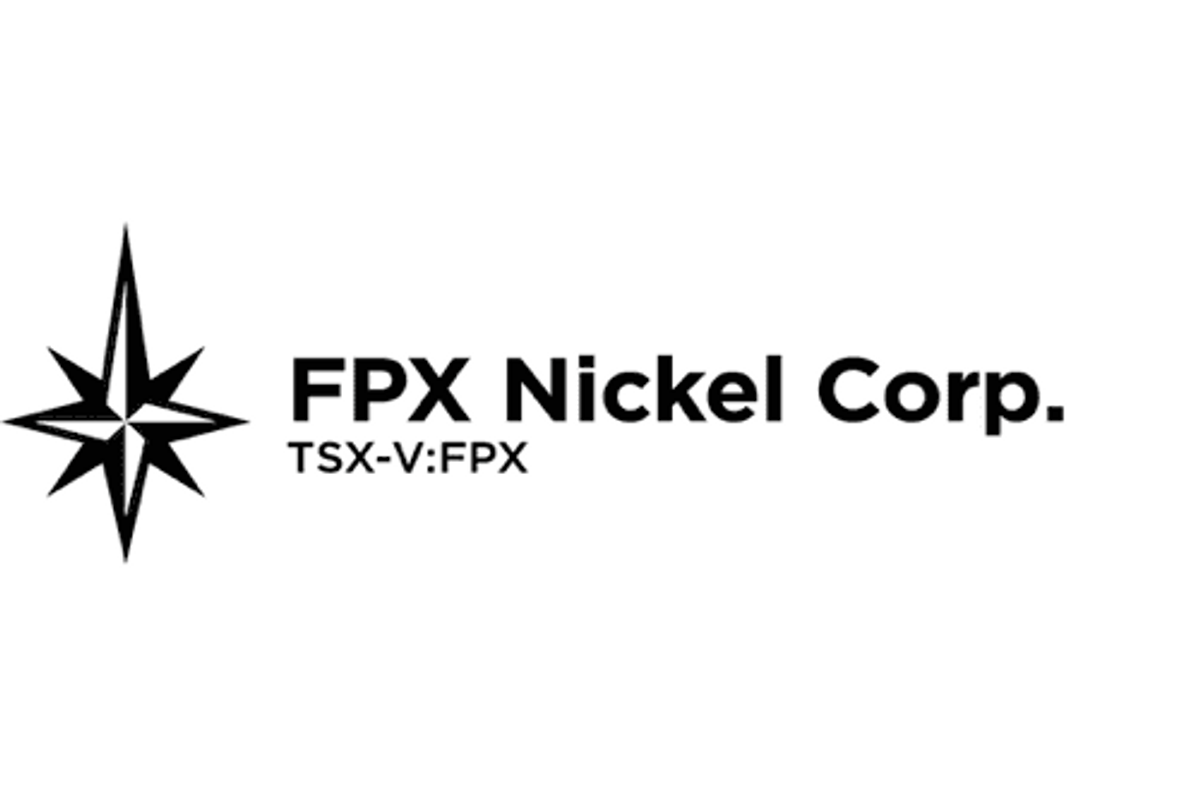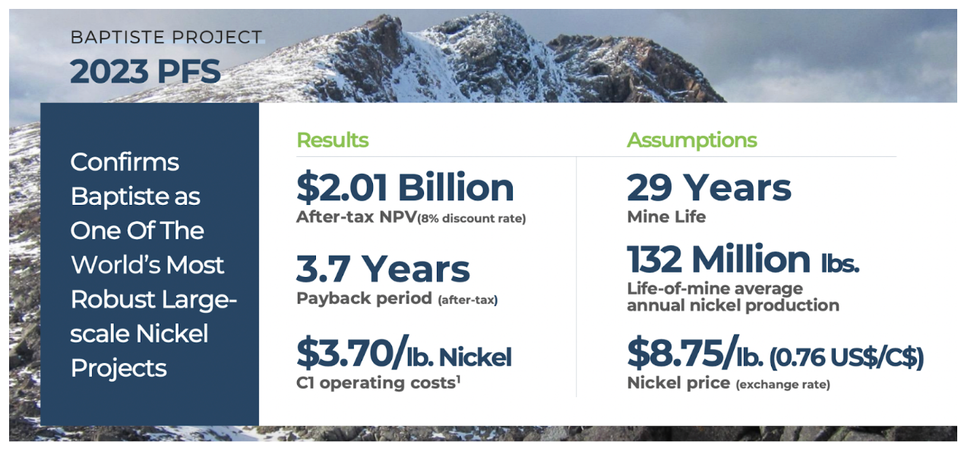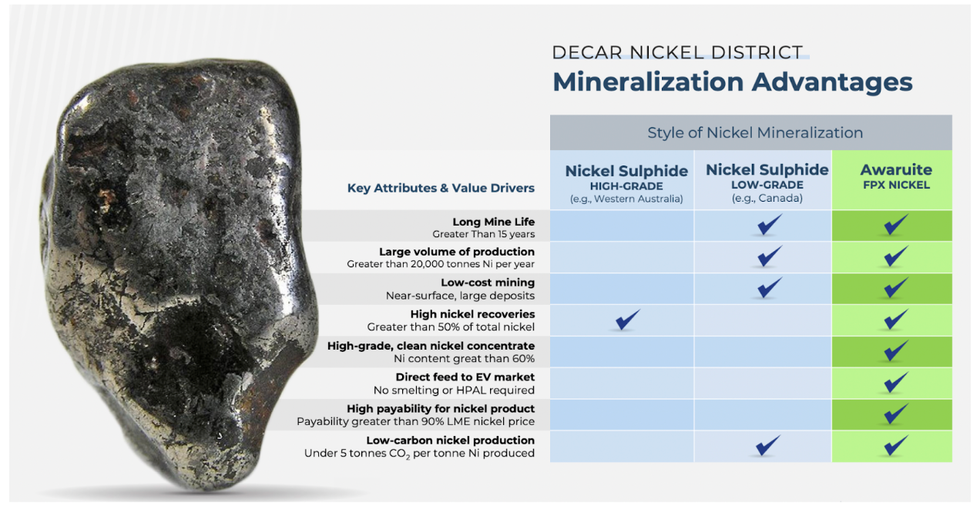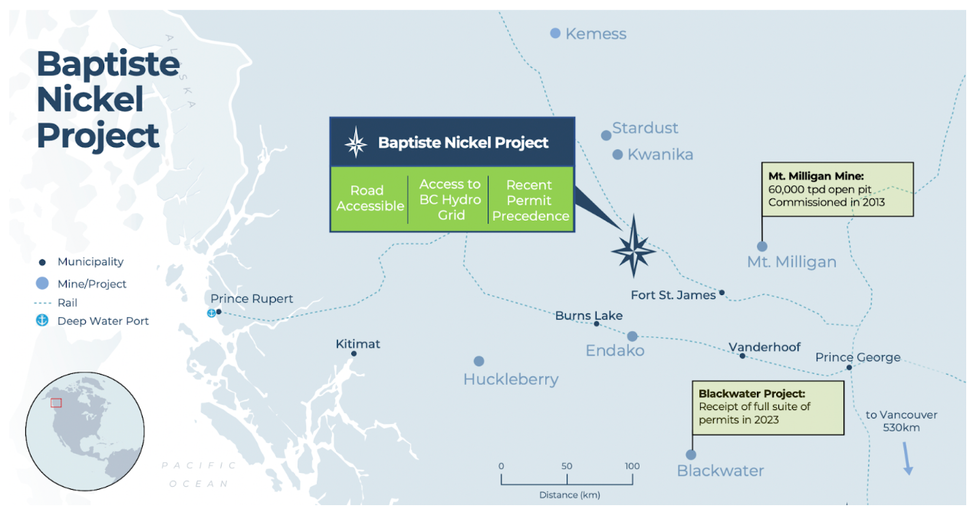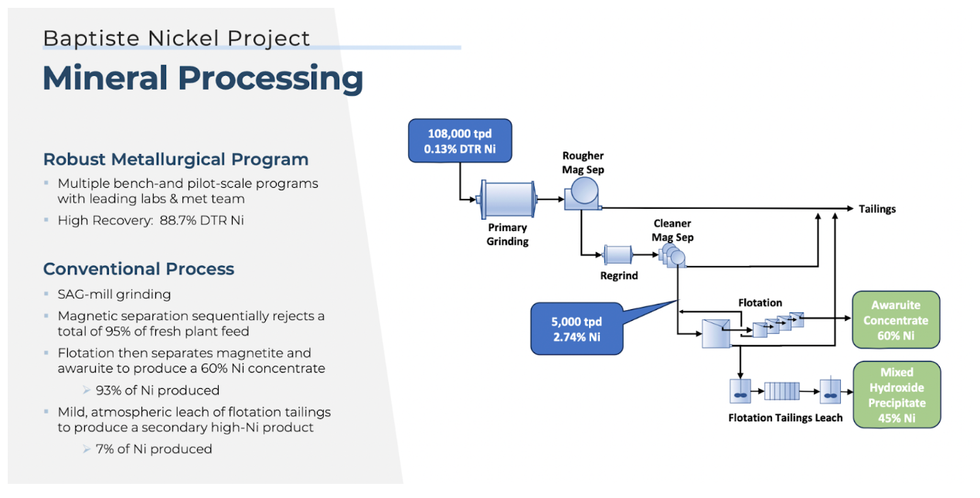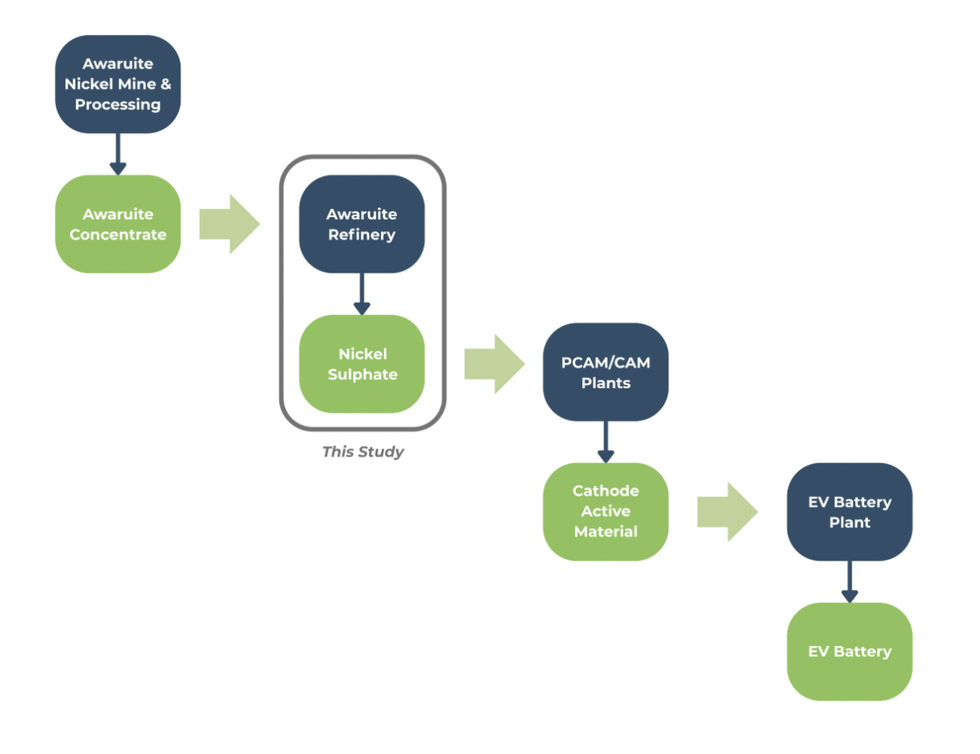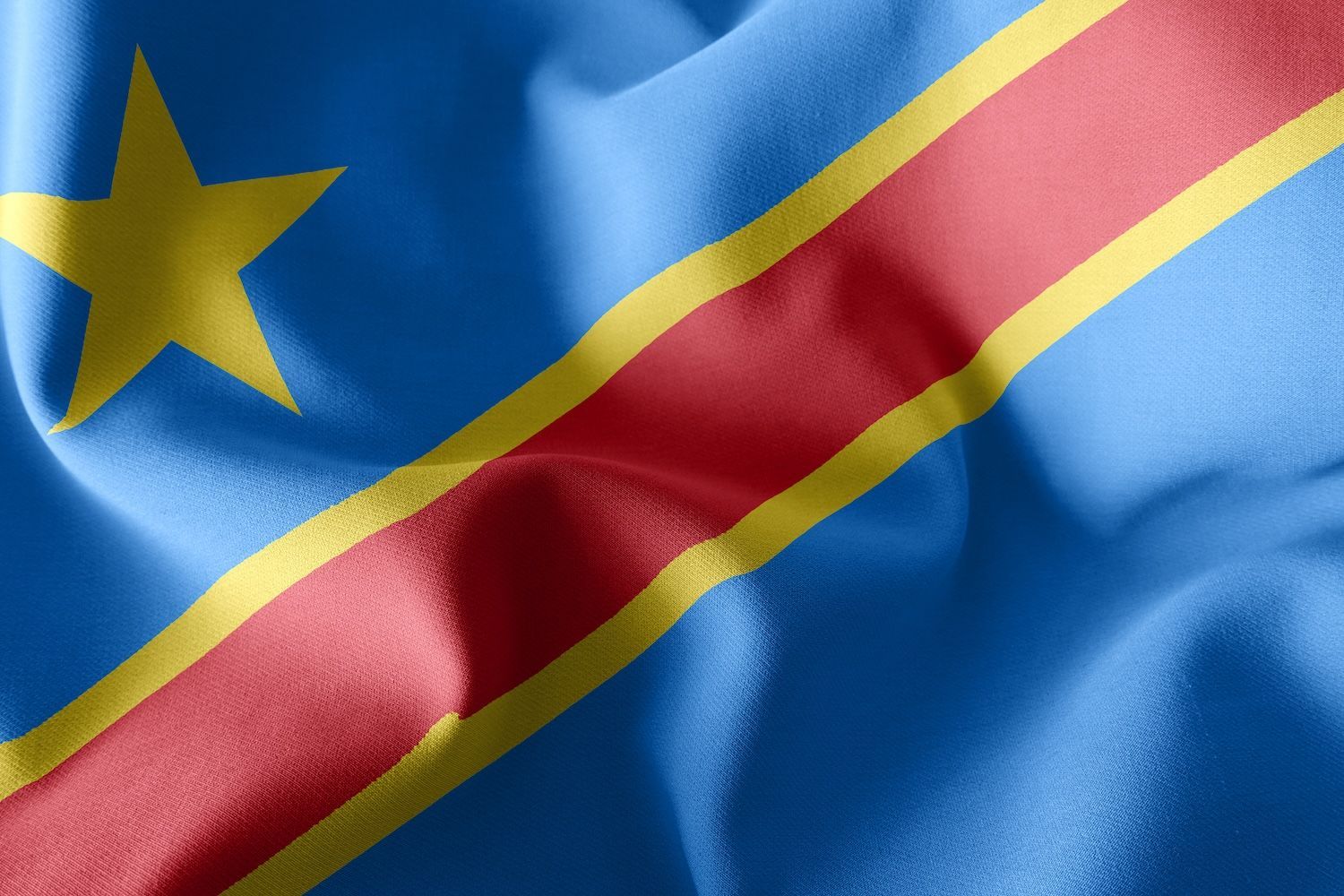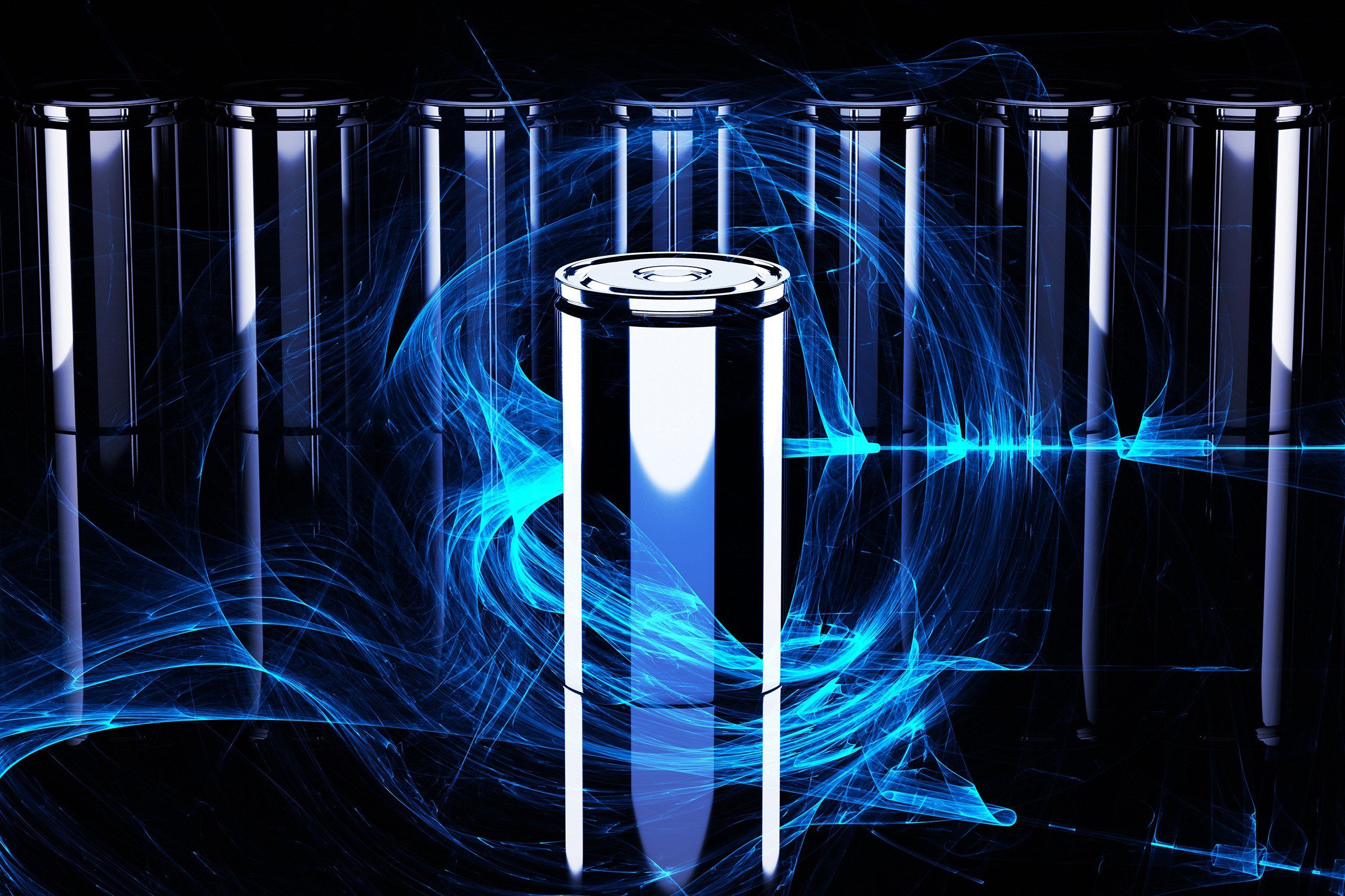FPX Nickel Corp. (TSXV: FPX) (" FPX " or the " Company ") is very pleased to announce the confirmation of a significant new nickel discovery from the maiden drilling program at the Van Target (" Van ") in the Company's Decar Nickel District (" Decar " or the " District ") in central British Columbia. The first two widely-spaced holes at Van, which is located 6 km north of the Baptiste Deposit (" Baptiste "), returned some of the strongest results in the District's history, highlighted by the results of the first hole (21VAN-001), which intersected among the highest-grading broad intervals of near-surface nickel mineralization ever drilled at Decar.
Highlights
- First two holes at Van show that the strong mineralization in previously reported outcrop samples continues to depth
- Hole 21VAN-001 intersected 101 m grading 0.150% DTR nickel (0.207% total nickel), starting at an approximate vertical depth of 27 m below surface, among the 8 highest-grading, near-surface intervals in the history of Decar (see Table 1 regarding vertical depth)
- Hole 21VAN-002, collared 350 m south-southwest along section from 21VAN-001, intersected 103 m grading 0.144% DTR nickel (0.215% total nickel), starting at an approximate vertical depth of 55 m below surface
- Nickel mineralization at Van occurs as disseminated awaruite (nickel-iron alloy) and in the same ophiolite host rocks as at Baptiste
- The results of VAN-001 and VAN-002 compare favourably with previous drilling results at Baptiste, which contains 1.996 billion tonnes of indicated resources at an average grade of 0.122% DTR nickel , plus 593 million tonnes of inferred resources with an average grade of 0.114% DTR nickel , both reported at a cut-off grade of 0.06% DTR nickel. Mineral resources are not mineral reserves and do not have demonstrated economic viability. See the resource estimate set out in FPX's NI 43-101 Technical Report – "Preliminary Economic Assessment – Baptiste Nickel Project, British Columbia, Canada ," with an effective date of September 9, 2020 , under the Company's SEDAR profile
"We are extremely pleased with these first drill results from Van, confirming the potential for this target to host a large-scale, standalone nickel deposit to rival the deposit already delineated at Baptiste, which is the world's third largest undeveloped nickel deposit*," commented Martin Turenne , the Company's President and CEO. "For context, the results of 21VAN-001 exceed the highest-grading, near-surface results achieved in any of the first 38 holes drilled at Baptiste between 2010 and 2012. We look forward to reporting additional assays from this year's nine-hole Van program in the coming weeks."
FPX's Chairman Peter Bradshaw added: "While we are in still in the very early stages of understanding the potential at Van, the results of the first two holes, drilled in the central portion of the large 2.5 km 2 target area, strengthen our view that the Decar Nickel District could host other large-scale deposits to support a district-scale, multi-generational nickel operation."
Link to view drill results within interactive 3D VRIFY model (for best results, view in full screen): https://vrify.com/embed/decks/10590-FPX-Nickel-Van-Target-Press-Release
Figure 1: Decar Nickel District
Van Target Drilling
The results of 21VAN-001 and 21VAN-002 are the first from a maiden nine-hole, 2,688 m drill program at the Van Target, which is located 6 km north of Baptiste at similar elevations, and accessible via logging roads (see Figure 1). Maiden drilling at Van was designed to test the sub-surface potential for mineralization in areas below and adjacent to prospective samples of outcropping bedrock, which had defined a target area of approximately 2.5 km 2 . The size of the Van Target defined by outcrop sampling is comparable to the Baptiste deposit, which measures 3 km along strike with widths of up to 1 km. All nine holes were drilled to the north-northeast at a declination of minus 50 degrees to a target depth of 350 m .
Table 1 – Van Target Drill Hole Results
| Hole | Intersections 1 | DTR Nickel (%) 2 | Total Nickel (%) 2 | ||
| From | To | Intersected | |||
| 21VAN-001 | 34.5 | 354 | 319.5 | 0.107 | 0.221 |
| including | 34.5 | 166 | 131.5 | 0.143 | 0.209 |
| including | 43 | 144 | 101 | 0.150 | 0.207 |
| and | 166 | 354 | 188 | 0.081 | 0.223 |
| | |||||
| 21VAN-002 | 16.1 | 351 | 334.9 | 0.121 | 0.213 |
| including | 29 | 91 | 74.9 | 0.075 | 0.205 |
| and | 91 | 194 | 103 | 0.144 | 0.215 |
| and | 194 | 351 | 157 | 0.128 | 0.215 |
| including | 237 | 339 | 102 | 0.136 | 0.212 |
1 The vertical depth (true width) of all quoted intersections in this news release is interpreted to be approximately 70% of downhole depth.
2 All mineralized core samples are assayed for "total nickel" and "Davis Tube Recoverable (" DTR ") nickel." "DTR nickel" analyses measure only the magnetically recoverable nickel hosted in awaruite (nickel-iron alloy), whereas the "total nickel" analyses measure both recoverable and refractory nickel, the latter hosted in silicate phases like olivine and, to a lesser extent, serpentine. The Davis Tube method is in effect a mini-scale metallurgical test procedure used to provide a more accurate measure of recoverable nickel and is the global industry-standard geometallurgical test for magnetic recovery operations and exploration projects. See "Sampling and Analytical Method", below.
The nickel mineralization intersected within 21VAN-001 and 21 VAN-002 is characterized by disseminated, coarse-grained awaruite (nickel-iron alloy) mineralization hosted in serpentinized ophiolitic rocks and is analogous to the mineralization and geological setting at the Baptiste Deposit.
21VAN-001 was collared in the central portion of the 2.5 km 2 target area and was drilled to the north-northeast at an angle of minus 50 degrees. The hole encountered bedrock at 34.5 m downhole (approximately 26 m vertical depth) and thereafter intersected 319.5 m of strong awaruite mineralization, to a downhole depth of 354 m . The strongest mineralization at 21VAN-001 was encountered near the top of hole, including a 101 m interval of 0.150% DTR nickel starting at downhole depth of 43 m (approximately 32 m vertical depth). Mineralization in this hole remains open at depth.
21VAN-002 was collared 350 m southwest along section from 21VAN-001 and was also drilled to the north-northeast at minus 50 degrees. The hole encountered bedrock at 16.1 m downhole (approximately 12 m vertical depth) and thereafter intersected 334.9 m of strong awaruite mineralization, grading 0.121% DTR nickel to a downhole depth of 351 m . 21VAN-002 is notable for multiple broad intercepts of strong nickel mineralization, including 0.144% DTR Ni over 103 m starting at a downhole depth of 91 m (approximately 68 m vertical depth), and 0.136% DTR Ni over 102 m starting at 237 m downhole (approximately 178 m vertical depth). Mineralization in this hole also remains open at depth.
Collar locations for the nine holes drilled at the Van Target are provided in Figure 2. Holes were spaced approximately 350 m apart and tested the Van Target over an area of approximately 1 km 2 to a maximum downhole depth of 350 m . Assays are pending for holes 21VAN-003 to 21VAN-009.
Figure 2: Van Target Plan Map with Drillhole Collar Locations and Previously Reported Outcrop Samples
Figure 3 – Van Target Cross Section with Assay Results and Lithology for 21VAN-001 and 21VAN-002
*Note: The Baptiste Deposit ranks as the world's third largest undeveloped nickel deposit, according to Mining Intelligence (see https://www.mining.com/featured-article/ranked-worlds-top-10-nickel-projects )
Sampling and Analytical Method
HQ & NQ drill core were quartered and halved respectively, using a diamond blade core cutting saw and sampled continuously downhole with the exception of post mineralization dikes and non-mineralized rock types that are unsampled and known to have zero grade. Drill core samples were cut on-site, sampled at nominal 4 m intervals, bagged and sealed with tamper proof tags and shipped to Activation Laboratories in Kamloops, British Columbia , for sample preparation. Sample preparation involved crushing the entire sample to 90% less than 2 mm, riffle splitting 250 g and pulverization of the split to >95% passing 74 microns. Analytical work was completed at Activation Laboratories in Ancaster, Ontario that included lithium metaborate/tetraborate fusion ICP and also DTR Ni analysis. DTR Ni analysis involves Davis tube magnetic separation from a 30 g split of the pulp through a Davis tube magnetic separator as a slurry using a constant flow rate of 400 millilitres per minute and magnetic field strength of 3,500 Gauss at a 45 degree angle to produce a magnetic fraction and non-magnetic fraction. The magnetic and non-magnetic fractions are dried and weighed. The magnetic fraction is analyzed by fusion X-Ray Fluorescence (" XRF ") that reports multi-element data including nickel, cobalt and chromium analysis. The DTR nickel grade is calculated by multiplying the XRF fusion nickel value by the weight of the magnetic fraction, divided by total recorded weight.
QA/QC procedures involved the analysis of field and prep duplicates, DTR replicates, insertion of certified reference materials, and non-certified blanks to assess the accuracy and precision of the Davis tube magnetic separation and XRF analysis that are used to determine the DTR nickel content. The Davis tube method is a bench scale metallurgical test procedure and is used to provide a more accurate measure of magnetically recoverable nickel and is the global, industry standard for geometallurgical testing for magnetic recovery operations and exploration projects.
Dr. Peter Bradshaw , P. Eng., FPX Nickel's Qualified Person under NI 43-101, has reviewed and approved the technical content of this news release.
About the Decar Nickel District
The Company's Decar Nickel District claims cover 245 km 2 of the Mount Sidney Williams ultramafic/ophiolite complex, 90 km northwest of Fort St. James in central British Columbia . The District is a two-hour drive from Fort St. James on a high-speed logging road.
Decar hosts a greenfield discovery of nickel mineralization in the form of a naturally occurring nickel-iron alloy called awaruite (Ni 3 Fe), which is amenable to bulk-tonnage, open-pit mining. Awaruite mineralization has been identified in four target areas within this ophiolite complex, being the Baptiste Deposit, and the B, Sid and Van targets, as confirmed by drilling in the first three plus petrographic examination, electron probe analyses and outcrop sampling on all four. Since 2010, approximately US $24 million has been spent on the exploration and development of Decar.
Of the four targets in the Decar Nickel District, the Baptiste Deposit, which was initially the most accessible and had the biggest known surface footprint, has been the focus of diamond drilling since 2010, with a total of 82 holes and over 31,000 m of drilling completed. The Sid target was tested with two holes in 2010 and the B target had a single hole drilled in 2011; all three holes intersected nickel-iron alloy mineralization over wide intervals with DTR nickel grades comparable to the Baptiste Deposit. The Van target was not drill-tested at that time as rock exposure was very poor prior to more recent logging activity. In 2021, the Company executed a maiden drilling program at Van which has returned promising results comparable with the strongest results at Baptiste.
As reported in the current NI 43-101 resource estimate, having an effective date of September 9, 2020 , the Baptiste Deposit contains 1.996 billion tonnes of indicated resources at an average grade of 0.122% DTR nickel, containing 2.4 million tonnes of nickel, plus 593 million tonnes of inferred resources with an average grade of 0.114% DTR nickel, containing 0.7 million tonnes of nickel, both reported at a cut-off grade of 0.06% DTR nickel. Mineral resources are not mineral reserves and do not have demonstrated economic viability.
About FPX Nickel Corp.
FPX Nickel Corp. is focused on the exploration and development of the Decar Nickel District, located in central British Columbia , and other occurrences of the same unique style of naturally occurring nickel-iron alloy mineralization known as awaruite.
On behalf of FPX Nickel Corp.
"Martin Turenne"
Martin Turenne , President, CEO and Director
Forward-Looking Statements
Certain of the statements made and information contained herein is considered "forward-looking information" within the meaning of applicable Canadian securities laws. These statements address future events and conditions and so involve inherent risks and uncertainties, as disclosed in the Company's periodic filings with Canadian securities regulators. Actual results could differ from those currently projected. The Company does not assume the obligation to update any forward-looking statement.
Neither the TSX Venture Exchange nor its Regulation Services Provider accepts responsibility for the adequacy or accuracy of this release.
SOURCE FPX Nickel Corp.

![]() View original content to download multimedia: https://www.newswire.ca/en/releases/archive/October2021/19/c8657.html
View original content to download multimedia: https://www.newswire.ca/en/releases/archive/October2021/19/c8657.html
